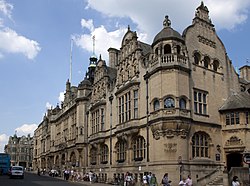
Sir Godfrey Kneller, 1st Baronet was a German-British painter. The leading portraitist in England during the late Stuart and early Georgian eras, he served as court painter to successive English and British monarchs, including Charles II of England and George I of Great Britain. Kneller also painted scientists such as Isaac Newton, foreign monarchs such as Louis XIV of France and visitors to England such as Michael Shen Fu-Tsung. A pioneer of the kit-cat portrait, he was also commissioned by William III of England to paint eight "Hampton Court Beauties" to match a similar series of paintings of Charles II's "Windsor Beauties" that had been painted by Kneller's predecessor as court painter, Peter Lely.

Cornmarket Street is a major shopping street and pedestrian precinct in Oxford, England that runs north to south between Magdalen Street and Carfax Tower.

In local government, a city hall, town hall, civic centre, guildhall, or municipal building is the chief administrative building of a city, town, or other municipality. It usually houses the city or town council, its associated departments, and their employees. It also usually functions as the base of the mayor of a city, town, borough, county or shire, and of the executive arm of the municipality.

Oxford City Council is the lower-tier local government authority for the city of Oxford in England, providing such services as leisure centres and parking. Social services, Education and Highways services are provided by Oxfordshire County Council.
Grandpont is a mainly residential area in south Oxford. It is west of Abingdon Road, and consists mainly of narrow streets that run at right angles to the main road, with terraced late-Victorian and Edwardian houses.

The Guildhall in Leicester, England, is a timber framed building, with the earliest part dating from c. 1390. The Guildhall once acted as the town hall for the city until the current one was commissioned in 1876. It is located in the old walled city, on a street now known as Guildhall Lane. It was used first as the meeting place for the Guild of Corpus Christi and then later for the more formal Corporation of Leicester. The hall was used for many purposes, including council meetings, feasts, as a courtroom, and for theatrical performances; the ultimatum given to the city during English Civil War was discussed here. It is a Grade I listed building, and the surrounding area, also including the Cathedral of St Martin's, is a conservation area, one of three in Leicester.

The Museum of Oxford(MOX) is a history museum in Oxford, England, covering the history of Oxford and its people. The museum includes both permanent and temporary displays featuring artefacts relating to Oxford's history from prehistoric times to the present day. The museum also acts as a public meeting space which people and organisations rent for both public and private events. Other activities facilitated by the museum include frequent public talks by historians and local cultural organisations, organised school tours, family activities, adult learning workshops, and an older people's program.
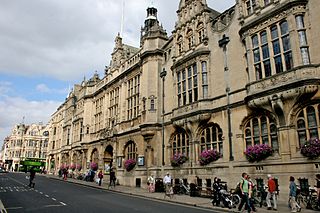
St Aldate's is a street in central Oxford, England, named after Saint Aldate, but formerly known as Fish Street.

Queen Street is a pedestrianised shopping street in central Oxford, England. It is one-way for buses and taxis, two-way for cyclists outside main shopping hours, and forbidden for cars. It runs west from the centre of Oxford at Carfax. Here it adjoins Cornmarket Street to the north, the High Street continuing east, and St Aldate's to the south.

Abingdon Road is the main arterial road to the south of the city of Oxford, England. The road passes through the suburbs of Grandpont and New Hinksey. It is named after the town of Abingdon to the south.
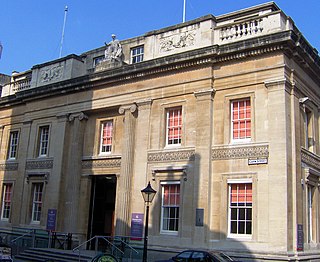
The Old Council House is a building on Corn Street, Bristol, England. It has been designated by English Heritage as a grade II* listed building.
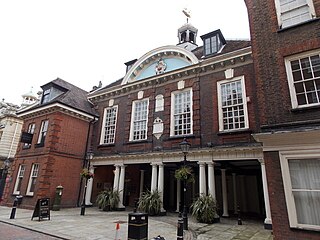
The Rochester Guildhall is an historic building located in the High Street in Rochester, Kent, England. It is a Grade I listed building.

St Mary's Hall is a municipal building in Bayley Lane in Coventry, West Midlands, England. It is a Grade I listed building.
Oxford City Police was the police force of the City of Oxford, England. It policed the city from 1 January 1869 until 31 March 1968.

Banbury Town Hall is a municipal facility in the High Street in Banbury, Oxfordshire, England. The town hall, which was the headquarters of Banbury Borough Council from its completion in 1854 until 1930, is a Grade II listed building.

Wokingham Town Hall is a municipal building in Wokingham, Berkshire, England. The building is the meeting place of Wokingham Town Council and is a Grade II* listed building.
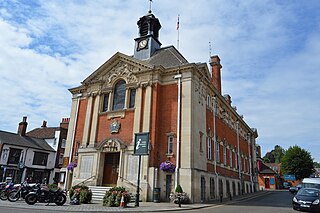
Henley Town Hall is a municipal structure in the Market Place in Henley-on-Thames, Oxfordshire, England. The town hall, which is the headquarters of Henley Town Council, is a Grade II* listed building.

The Moot Hall is a municipal building in the High Street in Maldon, Essex, England. The building, which was the headquarters of Maldon Borough Council, is a Grade I listed building.

Tiverton Town Hall is a municipal building in St Andrew Street in Tiverton, Devon, England. The structure, which was the meeting place of Tiverton Borough Council, is a Grade II listed building.

Great Torrington Town Hall is a municipal building in the High Street, Great Torrington, Devon, England. The town hall, which is the meeting place of Great Torrington Town Council, is a Grade II listed building.
